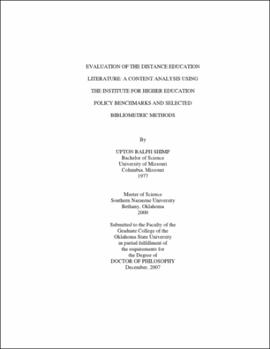| dc.contributor.advisor | Jordan, Patricia L. | |
| dc.contributor.author | Shimp, Upton Ralph | |
| dc.date.accessioned | 2013-11-26T08:34:53Z | |
| dc.date.available | 2013-11-26T08:34:53Z | |
| dc.date.issued | 2007-12 | |
| dc.identifier.uri | https://hdl.handle.net/11244/7570 | |
| dc.description.abstract | Scope and Method of Study: The primary purpose of this study was to determine what 2000 IHEP benchmarks were found in the recent distance education. A secondary purpose of this study was to identify the publications, authors, patterns, and relationships among those publications that contributed to the current body of research in distance education. The literature sample consisted of 278 journal articles from The American Journal of Distance Education, Journal of Distance Education, Distance Education, and Open Learning for the time period 2002 through 2006. The reference lists of the 278 journal articles contained a total of 7,754 citations. First, a content analysis identified the IHEP benchmarks that were found in the recent distance education literature. Second, bibliometric methods were used to analyze the patterns and relationships existing in the distance education literature among the associated bibliographic data. | |
| dc.description.abstract | Findings and Conclusions: The content analysis found three benchmarks which accounted for over 32 percent of the benchmarks found in the 278 journal articles. The top three benchmarks were (1) student/faculty interaction, (2) student/student interaction, and (3) communication collaboration. Pre-orientation to the distance education course and learner interaction with content were the two most frequently found new benchmarks in the literature sample. Moore was the most cited author and also had the most cited journal article and book. The American Journal of Distance Education, Journal of Distance Education, Distance Education, and Open Learning were also the most cited journal publications. Quantitative and descriptive accounted for 61 percent of the research methodologies utilized in the 278 journal article studies. Co-citation analysis created a cluster map displaying the literature connections between the most cited research in distance education. Overall results indicated that interaction is the most important quality factor in distance education. Future research could develop rubrics for quality benchmarks which would provide the criteria for evaluating quality in distance education. Expanded use of bibliometric methods could further develop the theoretical framework for research in distance education. | |
| dc.format | application/pdf | |
| dc.language | en_US | |
| dc.rights | Copyright is held by the author who has granted the Oklahoma State University Library the non-exclusive right to share this material in its institutional repository. Contact Digital Library Services at lib-dls@okstate.edu or 405-744-9161 for the permission policy on the use, reproduction or distribution of this material. | |
| dc.title | Evaluation of the distance education literature: A content analysis using the institute for higher education policy benchmarks and selected bibliometric methods | |
| dc.contributor.committeeMember | Prestamo, Anne | |
| dc.contributor.committeeMember | Miller, Janice | |
| dc.contributor.committeeMember | Goetze, Sandra | |
| dc.contributor.committeeMember | Beller, Caroline | |
| osu.filename | Shimp_okstate_0664D_2507 | |
| osu.accesstype | Open Access | |
| dc.type.genre | Dissertation | |
| dc.type.material | Text | |
| dc.subject.keywords | distance education | |
| dc.subject.keywords | content analysis | |
| dc.subject.keywords | bibliometrics | |
| dc.subject.keywords | quality | |
| dc.subject.keywords | benchmarks | |
| dc.subject.keywords | citation analysis | |
| thesis.degree.discipline | Education | |
| thesis.degree.grantor | Oklahoma State University | |
